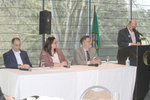

The retiring population and lack of flexibility in the employment practices and workplace are among the issues contributing to workforce shortages, according to presenters at the Lacey South Sound Chamber’s Workforce Symposium yesterday.
One of the panelists, Thurston County Chamber President/CEO David Schaffert, said the employment gap will be a long-term challenge. “The math is against you. You don't have enough people coming in behind that retiring workforce for all the jobs that are being created right now. So there's going to be a challenge for the next decade, probably more. It would be very fascinating to watch how it plays out,” Schaffert said.
He cited a mass exodus of older people quitting work and a new generation of employees viewing work differently.
William Westmoreland, chief executive officer at Pacific Mountain Workforce Development Council, shared that the older population not returning has put pressure on the workforce as a whole, which has been struggling to skill up people to replace the group of workers.
Schaffert said the Thurston Country Chamber is committed to providing services and resources to support employers to ensure that hiring practices are up to date. They also serve youth by connecting them to various career learning and career pathway development. “It is critical to ensure that youth understand where they want to be in life.”
10 "Guided Pathways" at SPSCC
Associate Dean of Workforce Education at South Puget Sound Community College Amy Warren said they have adopted “guided pathways” to help students get some idea of a career path.
The community college has 10 pathways, she added. These are:
“Some of our programs are designed to be two years. They come into the college and we give them work-ready skills - out into the workforce. Other programs are designed to help them transfer to a four-year school,” she said, adding part of her job is to reach out to industries and develop programs based on what the community needs.
Recognizing worldwide change
All three panelists agreed that the pandemic has changed the employment/work landscape.
“With COVID-19 experiences, please recognize world change,” Schaffert told the audience in the forum.
He suggested that employers revisit their employment practices and offer people flexible employment.
He emphasized the importance of culture in the organization.
“It is important for you to have a desirable place to work to retain your people not just because of compensation but because they enjoy being part of the organization. It is not only about dollars anymore,” Schaffert added.
Although compensation is one of the reasons cited for many quitting their job, he said others are looking for better work arrangements or opportunities within that compensation package.
To get workers off the sidelines, Westmoreland also advised employers to change their hiring practices.
More applicants through more appropriate job postings
He said they see job postings that reduce or push people out of the pool or cause candidates to not respond because of requirements.
“We see degree requirements on jobs that don’t require degrees. They could be accomplished with a short-term credential from the college or just experience. We see drug testing for roles that are not required – or necessary thing for insurance. These opt-outs, isolate, push out a large part of the local talent pool,” Westmoreland said.
Serving the underserved
The Pacific Mountain Workforce Development Council (PACMTN) connects employers and job seekers by creating a pipeline of skilled and talented workers to meet the needs of local employers and industries.
The PACMTN is an authorized entity to deliver the federal programming for Thurston as well as Grays Harbor, Lewis, Mason and Pacific counties.
Recently, the workforce development council received a $1.3 million award to help assist people who the opioid epidemic has negatively impacted to reenter the workforce.
“We start working with them prior to release and then continue that effort until they find a sustainable employment opportunity post-release,” Westmoreland said.
He said the award allows the PACMTN to focus on working with the most vulnerable populations.. They are people who are not typically represented in particular occupations.
“What we do in the workforce system is mitigate the barriers to employment and then connect them to in-demand high wage opportunities, or at least a career pathway to get to that,” Westmoreland said.
In this region, PACMTN mainly focuses on people in poverty and people reentering after incarceration.
Business of the Month: NTEF
The Lacey Sound South Chamber recognized North Thurston Education Foundation (NTEF) as Business of the Month at the same forum.
Mike Jones, executive director of the Lacey nonprofit organization, was at the forum to receive the recognition.
He said the support from the community has enabled them to do their mission, “getting [students] get into college.”
“Hundreds of kids that are seniors are in the low income…to graduate high school is a big deal for them. And for us to get them into college is an even bigger deal and break that cycle,” Jones said.
Comments
No comments on this item Please log in to comment by clicking here